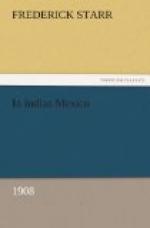We had hoped to start from Oaxaca in the early morning, but it was well on in the afternoon before all arrangements were completed. The doctor and his Mexican friend rode with us to Tule to see us well started. It was out over the old road to Mitla. The afternoon was hot, dust was deep, and a heavy wind blew it up into our faces in clouds. The sun was already setting when we rode into Santa Maria Tule, and we went at once to see the famous cypress tree, which no one in the party, save myself, had seen. It seems now to be a single tree, but was perhaps, originally, three; at present it displays a single, vast trunk, buttressed with heavy irregular projecting columns. So irregular is this enormous mass that no two persons taking its girth exactly agree. We measured it four feet above the ground and made the circumference one hundred and sixty feet. The mass of delicate green foliage above was compact, vigorous, and beautiful. Many years ago Humboldt cut a rectangular piece of bark from the old trunk and on the smooth surface thus exposed carved an inscription with his name.
[Illustration]
[Illustration]
Bark has since grown over the sides and corners of this tablet, but much of the inscription may still be read. Since Humboldt’s visit many lesser men have gashed the old tree to leave their mark.
As it was now darkening we hurried to the meson of the village. The old lady in charge received us with suspicion; she could not feed us and refused to receive us into the house for the night; she would permit us to sleep outside, in the corridor—which we might have done without asking permission. At this moment, the doctor’s friend remembered that he knew a man here and went out to reconnoitre; he soon returned and led us to his friend’s house, where we were well received. A supper of eggs, tortillas, and chocolate was soon served. Before we had finished the moon had risen and by its light the doctor and his friend started on their return to town. We slept on beds, made of boards laid upon sawhorses, in a grain store-room, where rats were running around all night long.
The next day, we were again at Mitla. It was a festival day, that of the Conversion of St. Paul the Apostle. In the evening there were rockets, the band played, and a company of drummers and chirimiya blowers went through the town. Senor Quiero had fires of blazing pine knots at the door. When the procession passed we noted its elements. In front was the band of ten boys; men with curious standards mounted on poles followed. The first of these standards was a figure, in strips of white and pink tissue paper, of a long-legged, long-necked, long-billed bird, perhaps a heron; next stars of colored paper, with lights inside; then were large globes, also illuminated, three of white paper and three in the national colors—red, white, and green. Grandest of all, however, was a globular banner of cloth on which was painted a




